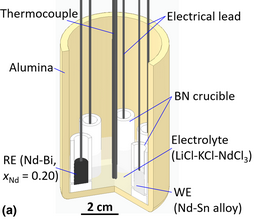Crossref Citations
This article has been cited by the following publications. This list is generated based on data provided by
Crossref.
Baldivieso, Stephanie Castro
Smith, Nathan D.
Im, Sanghyeok
and
Kim, Hojong
2021.
Thermodynamic properties of Gd-Bi alloys determined by emf measurements in LiCl-KCl-GdCl3 electrolyte.
Journal of Alloys and Compounds,
Vol. 886,
Issue. ,
p.
161229.
Lichtenstein, Timothy
and
Hawthorne, Krista L.
2022.
Solute- and solvent-based electromotive force cells for activity measurements of electroactive species in molten salts.
Electrochimica Acta,
Vol. 424,
Issue. ,
p.
140675.
Im, Sanghyeok
Shang, Shun-Li
Smith, Nathan D.
Krajewski, Adam M.
Lichtenstein, Timothy
Sun, Hui
Bocklund, Brandon J.
Liu, Zi-Kui
and
Kim, Hojong
2022.
Thermodynamic properties of the Nd-Bi system via emf measurements, DFT calculations, machine learning, and CALPHAD modeling.
Acta Materialia,
Vol. 223,
Issue. ,
p.
117448.
Pu, Zhenghao
Luo, Yiwa
Wang, Wei
Zhang, Guohua
Wang, Mingyong
Tu, Jiguo
Zhu, Hongmin
and
Jiao, Shuqiang
2022.
A universal study of liquid metal cathodes for direct extraction of titanium within a closed loop.
Journal of Cleaner Production,
Vol. 368,
Issue. ,
p.
133135.
Lichtenstein, Timothy
and
Hawthorne, Krista L.
2022.
Solute- and Solvent-Based Electromotive Force Cells for Activity Measurements of Electroactive Species in Molten Salts.
SSRN Electronic Journal ,
Ding, Li
Yang, Shanxin
Yan, Yongde
Xue, Yun
Ma, Fuqiu
Zhu, Kai
Liu, Wei
and
Deng, Yuan
2023.
Electrochemical and kinetic analysis of Ce recovery using Ga electrode in LiCl-KCl melt.
Separation and Purification Technology,
Vol. 323,
Issue. ,
p.
124492.
Guo, Lei
Gao, Shuaibo
Zhang, Yu
Li, Wenmiao
Du, Kaifa
Yin, Huayi
and
Wang, Dihua
2023.
Fundamentals of liquid metal displacement reactions: Emf measurements of Na-Sn, Li-Sn, Mg-Sn, and Ca-Sn.
Journal of Electroanalytical Chemistry,
Vol. 945,
Issue. ,
p.
117669.
Guo, Lei
Yin, Huayi
Li, Wenmiao
Wang, Shiyu
Du, Kaifa
Shi, Hao
Wang, Xu
and
Wang, Dihua
2024.
Liquid-metal-electrode-assisted electrolysis for the production of sodium and magnesium.
Journal of Magnesium and Alloys,
Guo, Lei
Gao, Shuaibo
Hu, Zuojun
Wu, Yongxin
Pang, Fangzhao
Yin, Huayi
and
Wang, Dihua
2024.
An electrolysis–displacement–distillation approach for the production of Li, Mg, Ca, Sr, and Ba metals.
Green Chemistry,
Vol. 26,
Issue. 5,
p.
2763.
